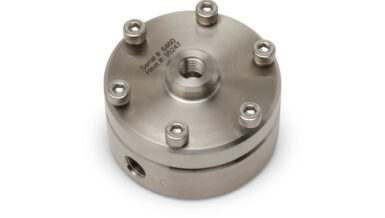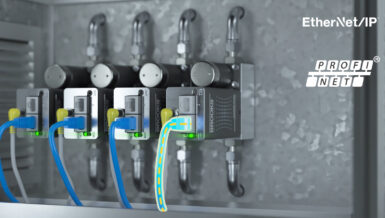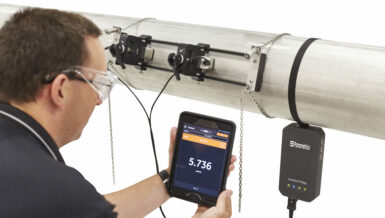They are tried and trusted with a reputation for accurate performance that can be relied upon. Typically, these flow meters are used on metering, test and production systems and separators, to measure oil and water and Gas being produced during well testing operations. They are also widely used in water reinjection applications, where hundreds of devices can be installed across entire fields, with on installed on every injection well.
A variation on the original flanged design is produced by several manufacturers in the form of a between flange or Wafer Pattern style body. This body style was introduced in response to customers’ requirements for reduced weight Size and cost, in combination with an easy to install design.
Wafer body flow meters have common body sizes e.g. 1” x 2”, 1.5” x 2 and 2” x 2”, where the first digit represents meter bore and the second digit represents the meter body size. This allows users to standardise on (in this example) 2” pipe size, while meters can be switched, to suit the flow rate being measured in each case. It is common on separator applications, to utilise several sizes in parallel to make up a wide operating envelope. The meter body has mating sealing surfaces, which align with the sealing surfaces on ANSI raised face (RF) or ring type joint (RTJ) flanges. Long bolts are used to clamp the meter between the users’ flanges and combined with alignment rings, ensures that the meters and flanges are perfectly aligned with the pipe bore. Normally, spiral wound gaskets are utilised to ensure sealing integrity.
Being a flangeless body, the weight of each between flange style flow meter is significantly lower than that of its equivalent flanged counterpart. Weight savings of greater than 70% can be achieved, especially in test separator or water injection applications, where 600, 900 or 1500 lb flanges are commonplace. Consider an example: a 2” 1500 lb RF flanged turbine flow meter could weigh in excess of 100 lb. If this meter were to be installed in a confined space, or in a desert or offshore location, the device may have to be manually handled into its final position. This could be extremely difficult or even impossible without scaffolding, forklift or crane access. A single wafer style meter is typically less than 10 lb including its associated totaliser, so it can be easily carried and installed by one man.
All of the current commonly available between flange turbine flow meter designs feature cast rotors, which are popular due to reduced initial capital costs. However, these designs conceal a higher cost of ownership cost, which does not become evident until later in the meter’s life. Each of these cast rotors is slightly different to the next, meaning that each meter has to be individually calibrated. This in itself is not a huge problem, since manufacturers are able to calibrate a handful of meters “per batch” applying the same average calibration factor across the entire batch. Others calibrate each individual flow meter, resulting in higher cost and reduced throughput of product which can lead to longer lead times.
The difference: with the Metri IC-BF Meter by CNC machining every rotor, every single rotor one can be manufactured to the same extremely high tolerance. Since rotors are identical in every detail, calibration data across all meters in each batch is almost identical.
Due to the very nature of the sand-casting process, a degree of rotor mass imbalance is inevitable. During use, the rotor will be inclined to wobble, however slightly, along the line of its shaft axis. This wobble causes the shaft and sleeve bearings to be loaded eccentrically, producing rotating wear. Over time, this rotating wear will erode the shaft OD reducing its strength and repeatability. Advantage: A combination of reduced rotational speed and increased blade count (in most cases) increases the IC-BF meters’ bearing life without reducing the output frequency. Since rotors and bearing supports are often supplied as a complete calibrated (and expensive) kit, cost of ownership can be significantly reduced, utilising a machined design. Flow meter resolution and therefore accuracy, is increased in line with increased blade count, since more pulses are produced for each unit of volume.
Finally, cast rotors are often supplied in only one material, so in cases of erosive or corrosive environments, when using the IC-BF Metri Meter alternative materials can be easily accommodated, due to the all machined designs. Life expectancy of each meter will be further enhanced.
To summarise, the use of CNC machined rotors in these inherently less costly, more reliable and lower weight devices, leads to better accuracy, longer lift and lower cost of ownership than conventional cast rotor designs.
The highly versatile single-flow direction IC-BF operates at between -101°C and 170°C as standard but can comfortably accommodate higher temperatures of up + 232°C.
It can be used in general purpose applications as well as more hazardous conditions which require ATEX IECEx FM and CSA approvals.
When it comes to locating one of the E or F series display on the IC-BF Wafer Pattern Turbine Flow Meter, these can be locally, compact mounted or remote mounted.
Additionally, the IC-BF can be combined with a range of other output/displays such as the Metri IC-DTS, IC-MV-PO pulsed output or IC-MV-AN analogue output for safe area applications.
The IC-BF is manufactured in the UK by (ICenta) Metri Measurements Ltd. Every component of the Metri IC-BF Wafer Pattern Turbine Flow Meter is constructed of the highest quality European sourced materials. Calibration is carried out on one of the company’s piston or gravimetric piston provers,
Each meter being supplied with a 5, 10 points calibration prior to being quality checked and shipped.
Working to ISO9001:2018































